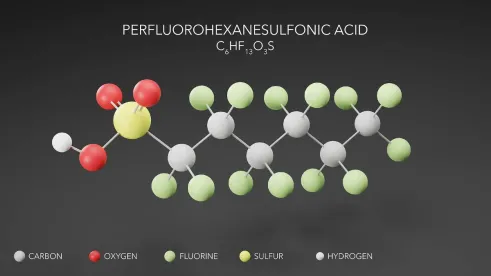Has the final bell rung for PFAS in food packaging? On February 28, 2024, the Food and Drug Administration (FDA) announced that all grease-proofing agents containing per- and polyfluoroalkyl substances (PFAS)[1] “are no longer being sold for use in food packaging in the U.S.”[2] A complete elimination of chemical substances is an uncommon FDA measure, and academics studying PFAS have heralded this FDA announcement as a victory for the public.[3] However, because it is a voluntary phase-out, food companies should not rely on this statement or assume that the packaging they use going forward is PFAS-free. Although California has instituted a ban on PFAS in food packaging, the FDA has not.
Widespread Interest in PFAS in Food and Food Packaging
In 2019, the FDA began testing nearly 800 samples of food products for certain PFAS chemicals.[4] In August 2021, the FDA published the results of its testing, which showed that 164 of the 167 foods tested had no detectable levels of the PFAS measured. In addition to the FDA testing on PFAS, a number of environmental advocacy and health organizations have warned that PFAS chemicals are sources of pollution and contamination, including the Natural Resources Defense Council, Earthjustice, and Breast Cancer Prevention Partners, to name a few. Due to the groundswell of concern from advocacy organizations regarding the impact of PFAS, PFAS are now regulated in a number of states, including California. California’s Safer Food Packaging and Cookware Act of 2021, AB 1200[5], was passed in an effort to protect consumers and the environment from PFAS by prohibiting the distribution and sale of food packaging[6] that contain PFAS chemicals starting January 1, 2023. As of January 1, 2024, it also requires cookware manufacturers to disclose on the product label and online product listings the presence of chemicals identified on the Department of Toxic Substances Control’s Candidate Chemicals “list of lists”, which includes PFAS chemicals.
Voluntary Removal of PFAS
Rather than banning PFAS in food packaging, the FDA announced that starting in January 2021, three manufacturers would begin a three-year phase-out of certain items containing PFAS in food contact substances[7] in the U.S. marketplace, with a fourth manufacturer voluntarily notifying the FDA that it stopped sales of those PFAS products[8]. Even after the phase-out period, the FDA anticipates that it will take up to 18 months to exhaust existing stocks of paper and paperboard products containing PFAS from the market. The FDA announced that it would monitor this voluntary phase-out through annual updates from the manufacturers, and also by obtaining samples from the manufacturers if future testing is needed.[9]
Takeaways
Food manufacturers and retailers should remain vigilant with respect to PFAS to protect themselves from litigation. They should obtain written confirmation from their packaging suppliers that PFAS have been eliminated and they should consider conducting their own testing to verify. Although some may view the FDA News Release on February 28, 2024 as the beginning of the end for PFAS in food packaging, the latest pronouncement is more likely to cause more confusion and uncertainty for companies.
FOOTNOTES
[1] “PFAS” is a catch-all term commonly used to refer to per- and polyfluoroalkyl substances. There are thousands of PFAS chemicals, and they are found in many different consumer, commercial, and industrial products. Many PFAS are known to break down very slowly over time. More on PFAS from the EPA located here: PFAS Explained (epa.gov).
[2] FDA, Industry Actions End Sales of PFAS Used in US Food Packaging | FDA
[3] PFAS ‘forever chemicals’ to officially be removed from food packaging, FDA says (msn.com)
[4] Questions and Answers on PFAS in Food | FDA
[5] Bill Text – AB-1200 Plant-based food packaging: cookware: hazardous chemicals.
[6] The bill defines “food packaging” to be a nondurable package, packaging component, or food service ware that is intended to contain, serve, store, handle, protect, or market food, foodstuffs, or beverages, and is comprised, in substantial part, of paper, paperboard, or other materials originally derived from plant fibers. It also defines “food packaging” to include food or beverage containers, take-out food containers, unit product boxes, liners, wrappers, serving vessels, eating utensils, straws, food boxes, and disposable plates, bowls, or trays.
[7] The term “food contact substance” (FCS) is defined in Section 409(h)(6) of the Federal Food, Drug, and Cosmetic Act as “any substance intended for use as a component of materials used in manufacturing, packing, packaging, transporting, or holding food if such use is not intended to have any technical effect in such food.”
[8] FDA Announces Voluntary Agreement with Manufacturers to Phase Out Certain Short-Chain PFAS Used in Food Packaging | FDA
[9] FDA Announces the Voluntary Phase-Out by Industry of Certain PFAS Used in Food Packaging | FDA




 />i
/>i
